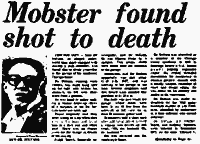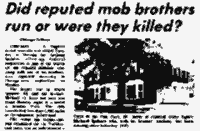Article
Note: This article was written in 2006. Sources that have become available more recently call into question some of its data and conclusions.
Anthony Spilotro wasn't much to look at. His build certainly wasn't threatening. He stood just five feet, six inches tall and weighed in the neighborhood of 160. His small stature led underworld colleagues to call him "Tony the Ant" and "The Little Guy." His face wasn't intimidating either. He had the look of a businessman. But there was something threatening in his blue eyes. The look was confident and detached and perhaps a little bored with the outside world. Behind those eyes, Anthony Spilotro seemed to be committing murder in his mind.

Spilotro
Spilotro's savage tendencies and a string of beatings and killings attributed to him caused him to be revered and feared within the Chicago Outfit. Despite his small physical stature, he rose within the Mafia ranks to become the Outfit's man in Las Vegas, the overlord of Sin City. He held that rank from 1971 until his ambition, his paranoia and his murderous rage conspired to bring him down a decade and a half later.
Born Anthony John Spilotro in Chicago on May 19, 1938, he was frequently in trouble with the law during his teen years. He was repeatedly arrested for burglary and other offenses. As a young adult, he became a collector for Sam DeStefano's Chicago shylocking operation, a job in which Spilotro's willingness to take apart another human being came in handy.
In the early 1960s, authorities believe Spilotro was responsible for the torture deaths of two unpaying DeStefano loan clients. He is widely believed to have forced hoodlum William McCarthy's (some sources refer to him as McCartney) head into a vise and then to have tightened that tool until one of McCarthy's eyes popped from his head. FBI Agent William Roemer said Spilotro was also responsible for the death of William "Action" Jackson. Jackson was hung up on a meat hook and tortured.
By the mid-1960s, Spilotro was a "made" member of the Outfit and became involved with some of Chicago's gambling ventures. He appears to have spent some time protecting Outfit interests in south Florida (Cuba had recently been closed to Mafiosi because of Fidel Castro's communist revolution there). He returned to Chicago after a few years and the Outfit began grooming him to take over its Las Vegas operations.
Chicagoans in Vegas

Stardust
Despite its closeness to Los Angeles, the "Mickey Mouse Mafia" failed to stake out a territory in Vegas, leaving the gambling oasis open for other mob families. The Chicago Outfit swept in with great force under the command of Johnny Roselli (Filippo Sacco). The Stardust and the Fremont Hotel were the Chicago Outfit's larger investment properties, but it also had a hand in other gambling facilities. Other crime families were also represented in Las Vegas to smaller degrees.
Roselli apparently did not squeeze as much out of Vegas casinos as the Chicago leadership wanted - or perhaps he squeezed plenty but kept a little too much for himself. Before 1960, Roselli was moved out in favor of Marshall Caifano. (Roselli organized some rackets on the West Coast and later in Florida before his dismembered remains were found floating in Biscayne Bay in summer of 1976).
Caifano's honeymoon period as Chicago's Vegas enforcer seems not to have lasted very long. The Outfit was reportedly offended by a series of violent outbursts by Caifano (who changed his name to Johnny Marshall) that it understood were bad for business in Vegas.

Caifano
When the Nevada Gaming Commission listed Caifano with ten others (including Chicago's Sam Giancana and Murray Humphries, Los Angeles's Louis Tom Dragna and Joe Sica and Kansas City's Nick and Carl Civella) in its inaugural "Black Book," the Chicago gangster reacted inappropriately. He brought legal action against the State of Nevada for excluding him from casinos and, in doing so, brought a great deal of media and governmental attention upon himself and his underworld associates. Making matters worse, Caifano lost his October 1960 case, strengthening the public perception of his ties to the Mafia.
The exposure of the court case was a nightmare to the Outfit. Caifano's prestige plummeted back home until 1964 when he was replaced. Some believe Roselli was temporarily returned to his old job. (It is worth noting that some conspiracy theorists believe Caifano was personally involved in the assassination of President John F. Kennedy in November of 1963.)
Haunted by his past
Anthony Spilotro was assigned to oversee the Outfit's Vegas interests about 1971. He moved into the community, bringing with him a number of underworld associates and a well-deserved reputation for violence.

DeStefano
But old Chicago crimes haunted Spilotro. In 1972, he was indicted for murder along with his old shylock employer Sam DeStefano and DeStefano's brother Mario. Sam DeStefano, known by that time as "Mad Sam," had a disturbing tendency of making a scene of himself while in courtrooms. He was known to appear in court in pajamas. Once he rolled in in a wheelchair, claiming poor health. He reportedly addressed one presiding judge through a bullhorn.
(While serving a perjury sentence at Stateville Penitentiary in 1968, Sam DeStefano was able to have himself transferred to Augustana Hospital, supposedly for urgent surgery. No surgery was performed, but DeStefano had a number of parties in his hospital room and conducted his shylocking business through a hospital telephone.)
Even if Sam DeStefano actually wasn'tmentally unbalanced, he certainly wasn't the sort of man one would wish to have as a codefendant.
Spilotro and Mario DeStefano succeeded in separating their trial from "Mad Sam's." But there was still concern throughout the Chicago underworld about what Sam might do and say when he was brought to trial. Early in April 1973, Sam DeStefano received a warning. While he and his wife were out, someone entered his Galewood home (1656 N. Sayre Street), apparently using some sort of pass key at the kitchen door. The intruder disabled a security system and robbed the home of a mink coat, a mink stole and a .30-caliber revolver. The minks were each valued at over $800. Police were called to investigate but could find no clue as to the thief's identity.

DeStefano's death
"Mad Sam" did not take the opportunity to change his address. On the morning of April 14, 1973, his remains were found in the garage of his home. DeStefano, dressed in work clothes, had been hit by two blasts from a 12-gauge shotgun. One destroyed his left arm. The other ripped through his upper body. Neighbors told police they had seen nothing. The authorities speculated that the murder had been planned for months.
Despite the testimony of an underworld informant, Spilotro managed to be acquitted of murder charges. Mario DeStefano, however, was convicted.
Spilotro was not yet in the clear. He subsequently faced murder charges in connection with the 1963 icepick murder of a Chicago loanshark. Some violence against state witnesses was sufficient to resolve that matter. Then, early in 1974, he and five other men were charged with misusing money from the Central States Teamsters Union pension fund. That case went to trial in March of 1975. By April, a federal judge ordered the acquittal of Spilotro and two other defendants.
A top man

Giancana
Back in Vegas, things were going well. Federal agents estimated that, through the 1970s, Spilotro's organization was able to skim hundreds of thousands of dollars each month from casino earnings. By putting a Mafia representative in a casino counting room, money could be withdrawn before totals were generated for tax records.
Through his ability to escape prosecution and his tremendous success managing Outfit interests in Las Vegas, little "Tony the Ant" Spilotro had quickly become a giant in the underworld. When Chicago's Sam Giancana was assassinated at his Oak Park home on June 19, 1975, the press circulated Spilotro's name as a possible successor. (The press was not aware that Giancana had been discredited in the underworld and replaced in Chicago due to unsuccessful involvement with U.S. intelligence agencies in the 1960s and due to his support of Kennedy's Presidential campaign.)
The press clippings probably went to the Ant's head because he shortly expanded his personal crime territory into Arizona. And, in addition to his assigned gambling interests, he started to run gangs involved in burglary, fencing of stolen goods, and drug trafficking.
| He terrorized his underlings. Rather than ensuring their loyalty, the tactic prompted several of them to seek the protection of federal agents. |
Authorities told the press in spring 1977 that Spilotro had partnered with Paul Schiro in the Phoenix, Arizona, region and was competing there with the underworld interests of New York's Bonanno clan. Spilotro, it was claimed, was funneling drugs from Mexico into the Chicago area through his Arizona territory. Federal agents valued the drug traffic at $8 million per year.
Spilotro was reaching out for more and more. At the same time, he was offending a number of his old friends. He terrorized his underlings. Rather than ensuring their loyalty, the tactic prompted several of them to seek the protection of federal agents. Spilotro also tended to bad mouth higher-ups back in Chicago. He probably resented sending so much of his own hard-earned money to Outfit administrators who had done little if anything to earn it.
One of Spilotro's underworld partners, Aladena "Jimmy the Weasel" Fratianno, was arrested late in 1977. That set events in motion that would lead to Spilotro's downfall.
Exposure
At the time, Mafia organizations had cultivated contacts within the Federal Bureau of Investigation. The underworld was therefore able to learn of Mafiosi who seemed ready to cooperate with investigators. Spilotro had apparently received information about conversations between federal agents and Fratianno. It appeared that Fratianno would be willing to testify against some of his former associates in exchange for $10,000.

Fratianno
Spilotro sent word to Fratianno that he would give him an immediate payment of $10,000 and "all the money he wanted" later on, if Fratianno would remain silent.
Subsequent arrests of Los Angeles mob leaders for the 1977 killing of Frank Bompensiero, who served in the dual role of government informant and San Diego crime boss, convinced L.A. boss Dominic Brooklier and Spilotro that Fratianno had decided to talk. In fact, Fratianno claimed he did not decide to cooperate with investigators until after he learned that Spilotro and Brooklier had ordered him killed.
Once again, Spilotro's tendency toward violence had helped send an ally to the other side.
By the end of 1978, Fratianno was supplying evidence to federal agents and prosecutors, and Spilotro's involvement in Las Vegas casinos was clear. The Nevada Gaming Commission added Anthony Spilotro to its Black Book in December 1978.
The following summer, investigators began to pick apart the company that managed the Stardust and the Fremont. That company was ostensibly run by Allen R. Glick, but the government discovered that Glick was fronting for Spilotro and the Chicago Outfit. Spilotro's partnership in a nationwide gambling racket based in Ohio was also discovered, as was his cooperation on gambling ventures with representatives of the Kansas City, Milwaukee and St. Louis crime families.
The Internal Revenue Service was involved in the investigations by early December of 1980. Narcotics agents joined the pile-on early in 1983. Las Vegas agents tried to catch Spilotro in a narcotics sting operation, but the savvy gangster refused to step into the trap.
Brother Michael

Michael
Spilotro
Anthony Spilotro's brother Michael, who remained behind in Chicago, was throwing his weight around. Michael, six years younger than Anthony, probably idolized his wealthy and powerful sibling.
Michael was affiliated with the Outfit but not yet an inducted member. His primary source of income was local gambling rackets.
In the early 1980s, he began to use the same strongarm tactics as his brother, while taking over rival bookmaking operations. Michael appeared to believe that his brother's name was all the protection he needed as he became increasingly noteworthy and increasingly hated in the Chicago underworld.
| "'The United States of America versus Anthony Spilotro.' Now what kind of odds are those?" |
Decline
In the middle of October, 1983, federal investigators had all the information they required. Spilotro and 14 other racketeers from Chicago, Milwaukee and Kansas City crime families were indicted in connection with a multi-million-dollar casino skimming conspiracy.
Spilotro's co-defendants in the case were:
- From Chicago - Joseph J. Aiuppa, 76; Anthony Chiavola Sr., 64; John P. Cerone, 69; and three others.
- From Milwaukee - Frank P. Balistrieri, 64 (at the time he had just been convicted of involvement in a sports betting ring; and two others.
- From Kansas City - Carl J. Civella; and two others.
- Also indicted were Milton D. Rockman, 75, of Cleveland, and another man from Las Vegas.
- Deceased Nick Civella, James V. Torrello, Allen Dorfman and Joseph V. Agosto were named as co-conspirators.
A quote attributed to Anthony Spilotro at the time was: "'The United States of America versus Anthony Spilotro.' Now what kind of odds are those?"
The indictments virtually shut off the flow of Vegas gambling dollars into the Chicago, Milwaukee and Kansas City families. That tremendous loss of income was widely blamed on the mistakes of Anthony Spilotro. His ambition had led to notoriety. His suspicion and hostility had caused productive Mafiosi to become damaging government witnesses.
Spilotro once again proved a winner in the courtroom. His April 1986 racketeering trial ended in a mistrial. But Spilotro's fate was probably already sealed. As federal prosecutors geared up for a retrial, Spilotro was called to Chicago to meet with his superiors.
In June, Anthony and Michael Spilotro were reported missing.
The End
Columnist Mike Royko joked at the time about using Chicago's rich underworld history as a lure to tourists.
"Before writing this," said a mid-June Royko column, "I looked at the national news wires to see what the biggest Chicago news story was today... The big story was the disappearance of mobster Tony Spilotro, who runs the Chicago gang's interests in Las Vegas, and his brother Mike, both of whom are now presumed to be resting peacefully in the trunk of a car."

By the time Royko's column reached the hands of readers, state police had already discovered the bodies of Anthony and Michael Spilotro in shallow graves in a cornfield on the outskirts of Enos, Indiana. The two men had been stripped to their underwear. They had obviously been beaten about their heads and upper bodies.
The bodies were identified through the use of dental records supplied by a third Spilotro brother, who was a dentist.
When the official cause of death came back as asphyxiation, the media jumped to the incorrect conclusion that the brothers had been buried while still alive.
The time and date of death was fixed at about 9 p.m. on June 14. No one had seen or heard from either Spilotro after 4 p.m. on June 14, 1986, when they were observed leaving Michael's Oak Park home. An FBI report indicated that the brothers were heading out to a meeting with Outfit higher-ups. Both had received telephoned orders on the 13th to attend the meeting. Michael had been contacted at his restaurant, named Hoagie's.
Anthony Spilotro's car was later found in the parking lot of a motel at Schiller Park.
Investigation
Indiana State Police, the FBI and the Violent Crime Apprehension Program cooperated on a murder investigation that lasted for nearly two decades.
| Michael had stepped on too many toes and had to be eliminated. |
Informant Frank Culotta, who began cooperating after his longtime friend Anthony Spilotro began plotting against his life, told authorities that Michael's activities were to blame for the two deaths. Michael had stepped on too many toes and had to be eliminated. Outfit bosses decided that Anthony could not be left alive to avenge his brother.
Federal agents attempted for a while to acquire information from a Chicago bigshot named Albert "Caesar" Tocco, who was believed to be one of a half dozen men who beat and killed the Spilotro brothers. Tocco was sentenced to 200 years in prison after his wife testified against him in the late 1980s. For additional leverage, agents tried to have Tocco convicted of a capital crime which would carry a death penalty. They apparently were unsuccessful, and Tocco died at the age of 77 in an Indiana prison on Sept. 21, 2005.
Recently, informant Nick Calabrese has been able to clear up much of the mystery surrounding the Spilotro murders. According to Calabrese, Anthony Spilotro had to pay the price for the loss of Vegas income and for his crew members who had been cooperating with the law.
Calabrese stated that the Spilotros were lured to the basement of a Bensenville home with the story that Michael was about to be inducted into the Outfit. Once there, the two brothers were beaten with fists, feet and gun butts and then strangled to death. The bodies were dumped in previously dug holes in the Indiana cornfield.
With Calabrese's help, the FBI arrested eleven men in April of 2005, charging them with involvement in 18 murders, including those of the Spilotros.
